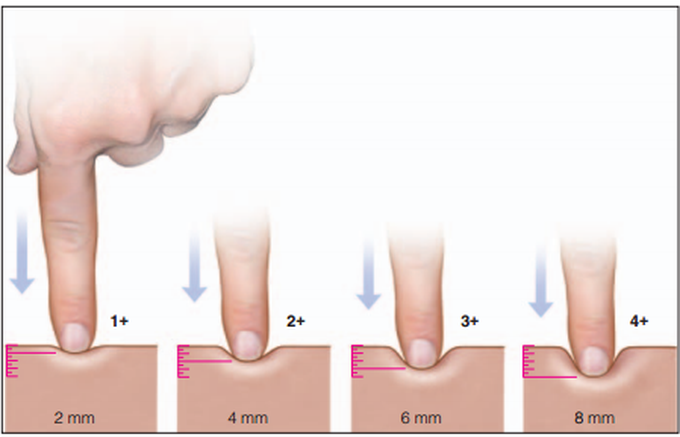


Grading of edema
Pitting edema is graded on a scale from 1 to 4, which is based on both the depth the "pit" leaves and how long the pit remains. A patient with a score of 1 has edema that is slight (roughly 2mm in depth) and disappears rapidly. A score of 2 is deeper (4mm) and disappears within 15 seconds. A score of 3 is deeper yet (6mm), and can last longer than a minute; in stage 3 pitting edema the extremity also looks grossly swollen. Finally, stage 4 is the most severe with deep pitting (8mm or greater in depth) that may last more than 2 minutes Causes Pitting edema is most commonly seen in patients with heart, liver, or kidney failure. These three conditions cause the body to hold onto excess sodium and water. It can also be seen in patient's with rheumatological diseases such as rheumatoid arthritisand systemic lupus erythematosus. Pitting edema can also be seen in patients receiving excess intravenous fluids. Regardless of the cause, the excess fluid leaks out of the capillaries and into the surrounding tissues. When it leaks into the subcutaneous tissues it is seen clinically as pitting edema. It is important to note that if pitting edema is present, the patient may also be "leaking" fluid into the lung's airspaces and abdominal cavity. If significant lung edema is present a patient may experience shortness of breath, and potentially respiratory failure. If edema is present in the abdominal cavity (aka: peritoneal cavity) it is known as ascites.
Living with Lupus is often a battle not just against the illness itself, but also against the emotional weight of uncertainty, fatigue, and the toll of long-term medications. For one courageous woman, that battle began in 2013. Diagnosed after Lupus had already affected her joints and internal organs, she was quickly placed on medication that initially helped. But as time went on, her health declined again this time with more frequent flare-ups and increasingly difficult side effects. Like many others with chronic illness, she faced the crushing weight of hopelessness. Each day became harder than the last, and conventional treatments no longer offered the comfort they once did. But in March 2020, at her lowest point, she made a decision that changed everything.Out of desperation and with a healthy dose of skepticism she turned to NaturePath Herbal Clinic, hoping their natural Lupus treatment might offer at least some relief. What happened next went far beyond her expectations.After completing a six-month herbal program, her flare-ups stopped entirely. Her energy returned. The chronic pain that had defined her daily life began to fade. For the first time in years, she felt like herself again. Not just alive but truly living.Her story is not just one of healing; it’s one of resilience, open-mindedness, and the courage to try something new when all else fails. By sharing her journey, she hopes to offer something priceless to others living with Lupus: hope.This treatment has been a true breakthrough for her. If you’re searching for a safe, natural, and effective alternative, I genuinely recommend giving this a chance.”www.naturepathherbalclinic.com or email them at info@naturepathherbalclinic.com


